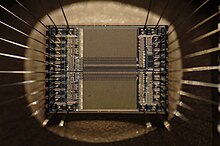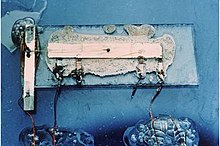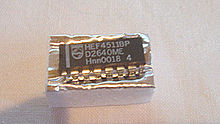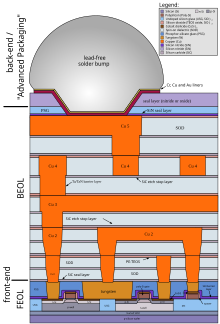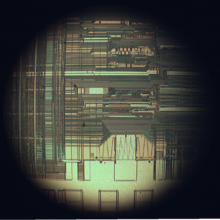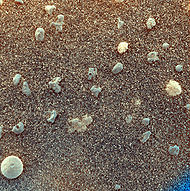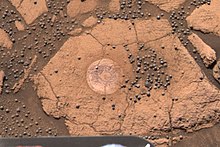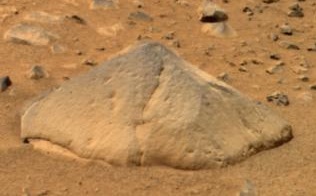Erasable Programmable Read-Only Memory (EPROM) integrated circuits. These packages have a transparent window that shows the die inside. The window is used to erase the memory by exposing the chip to ultraviolet light.
Integrated
circuit from an EPROM memory microchip showing the memory blocks, the
supporting circuitry and the fine silver wires which connect the
integrated circuit die to the legs of the packaging.
Virtual detail of an integrated circuit through four layers of planarized copper interconnect, down to the polysilicon (pink), wells (greyish), and substrate (green)
An integrated circuit or monolithic integrated circuit (also referred to as an IC, a chip, or a microchip) is a set of electronic circuits on one small flat piece (or "chip") of semiconductor material that is normally silicon. The integration of large numbers of tiny transistors
into a small chip results in circuits that are orders of magnitude
smaller, cheaper, and faster than those constructed of discrete electronic components. The IC's mass production capability, reliability and building-block approach to circuit design
has ensured the rapid adoption of standardized ICs in place of designs
using discrete transistors. ICs are now used in virtually all
electronic equipment and have revolutionized the world of electronics. Computers, mobile phones, and other digital home appliances are now inextricable parts of the structure of modern societies, made possible by the small size and low cost of ICs.
Integrated circuits were made practical by mid-20th-century technology advancements in semiconductor device fabrication.
Since their origins in the 1960s, the size, speed, and capacity of
chips have progressed enormously, driven by technical advances that fit
more and more transistors on chips of the same size – a modern chip may
have many billions of transistors in an area the size of a human fingernail. These advances, roughly following Moore's law,
make computer chips of today possess millions of times the capacity and
thousands of times the speed of the computer chips of the early 1970s.
ICs have two main advantages over discrete circuits: cost and performance. Cost is low because the chips, with all their components, are printed as a unit by photolithography
rather than being constructed one transistor at a time. Furthermore,
packaged ICs use much less material than discrete circuits. Performance
is high because the IC's components switch quickly and consume
comparatively little power because of their small size and close
proximity. The main disadvantage of ICs is the high cost to design them and fabricate the required photomasks. This high initial cost means ICs are only practical when high production volumes are anticipated.
Terminology
An integrated circuit is defined as:
A circuit in which all or some of the circuit elements are inseparably associated and electrically interconnected so that it is considered to be indivisible for the purposes of construction and commerce.
Circuits meeting this definition can be constructed using many different technologies, including thin-film transistors, thick-film technologies, or hybrid integrated circuits. However, in general usage integrated circuit has come to refer to the single-piece circuit construction originally known as a monolithic integrated circuit.
Arguably, the first examples of integrated circuits would include the Loewe 3NF. Although far from a monolithic construction, it certainly meets the definition given above.
Invention
Early developments of the integrated circuit go back to 1949, when German engineer Werner Jacobi (Siemens AG) filed a patent for an integrated-circuit-like semiconductor amplifying device showing five transistors on a common substrate in a 3-stage amplifier arrangement. Jacobi disclosed small and cheap hearing aids as typical industrial applications of his patent. An immediate commercial use of his patent has not been reported.
The idea of the integrated circuit was conceived by Geoffrey Dummer (1909–2002), a radar scientist working for the Royal Radar Establishment of the British Ministry of Defence. Dummer presented the idea to the public at the Symposium on Progress in Quality Electronic Components in Washington, D.C. on 7 May 1952. He gave many symposia publicly to propagate his ideas and unsuccessfully attempted to build such a circuit in 1956.
A precursor idea to the IC was to create small ceramic squares
(wafers), each containing a single miniaturized component. Components
could then be integrated and wired into a bidimensional or
tridimensional compact grid. This idea, which seemed very promising in
1957, was proposed to the US Army by Jack Kilby and led to the short-lived Micromodule Program (similar to 1951's Project Tinkertoy). However, as the project was gaining momentum, Kilby came up with a new, revolutionary design: the IC.
Jack Kilby's original integrated circuit
Newly employed by Texas Instruments,
Kilby recorded his initial ideas concerning the integrated circuit in
July 1958, successfully demonstrating the first working integrated
example on 12 September 1958. In his patent application of 6 February 1959,
Kilby described his new device as "a body of semiconductor material …
wherein all the components of the electronic circuit are completely
integrated." The first customer for the new invention was the US Air Force.
Kilby won the 2000 Nobel Prize in Physics for his part in the invention of the integrated circuit. His work was named an IEEE Milestone in 2009.
Half a year after Kilby, Robert Noyce at Fairchild Semiconductor developed a new variety of integrated circuit, more practical than Kilby's implementation. Noyce's design was made of silicon, whereas Kilby's chip was made of germanium. Noyce credited Kurt Lehovec of Sprague Electric for the principle of p–n junction isolation, a key concept behind the IC. This isolation allows each transistor to operate independently despite being part of the same piece of silicon.
Fairchild Semiconductor was also home of the first silicon-gate IC technology with self-aligned gates, the basis of all modern CMOS integrated circuits. The technology was developed by Italian physicist Federico Faggin in 1968. In 1970, he joined Intel in order to develop the first single-chip central processing unit (CPU) microprocessor, the Intel 4004, for which he received the National Medal of Technology and Innovation in 2010. The 4004 was designed by Busicom's Masatoshi Shima and Intel's Ted Hoff in 1969, but it was Faggin's improved design in 1970 that made it a reality.
Advances
Advances
in IC technology, primarily smaller features and larger chips, have
allowed the number of transistors in an integrated circuit to double
every two years, a trend known as Moore's law.
This increased capacity has been used to decrease cost and increase
functionality. In general, as the feature size shrinks, almost every
aspect of an IC's operation improves. The cost per transistor and the switching power consumption per transistor goes down, while the memory capacity and speed go up, through the relationships defined by Dennard scaling.
Because speed, capacity, and power consumption gains are apparent to
the end user, there is fierce competition among the manufacturers to use
finer geometries. Over the years, transistor sizes have decreased from
10s of microns in the early 1970s to 10 nanometers in 2017 with a corresponding million-fold increase in transistors per unit
area. As of 2016, typical chip areas range from a few square millimeters to around 600 mm2, with up to 25 million transistors per mm2.
The expected shrinking of feature sizes and the needed progress in related areas was forecast for many years by the International Technology Roadmap for Semiconductors (ITRS). The final ITRS was issued in 2016, and it is being replaced by the International Roadmap for Devices and Systems.
Initially, ICs were strictly electronic devices. The success of
ICs has led to the integration of other technologies, in an attempt to
obtain the same advantages of small size and low cost. These
technologies include mechanical devices, optics, and sensors.
- Charge-coupled devices, and the closely related active pixel sensors, are chips that are sensitive to light. They have largely replaced photographic film in scientific, medical, and consumer applications. Billions of these devices are now produced each year for applications such as cellphones, tablets, and digital cameras. This sub-field of ICs won the Nobel prize in 2009.
- Very small mechanical devices driven by electricity can be integrated onto chips, a technology known as microelectromechanical systems. These devices were developed in the late 1980s and are used in a variety of commercial and military applications. Examples include DLP projectors, inkjet printers, and accelerometers and MEMS gyroscopes used to deploy automobile airbags.
- Since the early 2000s, the integration of optical functionality (optical computing) into silicon chips has been actively pursued in both academic research and in industry resulting in the successful commercialization of silicon based integrated optical transceivers combining optical devices (modulators, detectors, routing) with CMOS based electronics. Integrated optical circuits are also being developed, using the emerging field of physics known as photonics.
- Integrated circuits are also being developed for sensor applications in medical implants or other bioelectronic devices. Special sealing techniques have to be applied in such biogenic environments to avoid corrosion or biodegradation of the exposed semiconductor materials.
As of 2018, the vast majority of all transistors are fabricated in a
single layer on one side of a chip of silicon in a flat 2-dimensional planar process. Researchers have produced prototypes of several promising alternatives, such as:
- various approaches to stacking several layers of transistors to make a three-dimensional integrated circuit (3DIC), such as through-silicon via, "monolithic 3D", stacked wire bonding, and other methodologies.
- transistors built from other materials: graphene transistors, molybdenite transistors, carbon nanotube field-effect transistor, gallium nitride transistor, transistor-like nanowire electronic devices, organic field-effect transistor, etc.
- fabricating transistors over the entire surface of a small sphere of silicon.
- modifications to the substrate, typically to make "flexible transistors" for a flexible display or other flexible electronics, possibly leading to a roll-away computer.
Design
The cost of designing and developing a complex integrated circuit is quite high, normally in the multiple tens of millions of dollars. Therefore, it only makes economic sense to produce integrated circuit products with high production volume, so the non-recurring engineering (NRE) costs are spread across typically millions of production units.
Modern semiconductor chips have billions of components, and are
too complex to be designed by hand. Software tools to help the designer
are essential. Electronic Design Automation (EDA), also referred to as Electronic Computer-Aided Design (ECAD), is a category of software tools for designing electronic systems, including integrated circuits. The tools work together in a design flow that engineers use to design and analyze entire semiconductor chips.
Types
Integrated circuits can be classified into analog, digital and mixed signal, consisting of both analog and digital signaling on the same IC.
Digital integrated circuits can contain anywhere from one to billions of logic gates, flip-flops, multiplexers,
and other circuits in a few square millimeters. The small size of
these circuits allows high speed, low power dissipation, and reduced manufacturing cost compared with board-level integration. These digital ICs, typically microprocessors, DSPs, and microcontrollers, work using boolean algebra to process "one" and "zero" signals.
Among the most advanced integrated circuits are the microprocessors or "cores", which control everything from personal computers and cellular phones to digital microwave ovens. Digital memory chips and application-specific integrated circuits (ASICs) are examples of other families of integrated circuits that are important to the modern information society.
In the 1980s, programmable logic devices
were developed. These devices contain circuits whose logical function
and connectivity can be programmed by the user, rather than being fixed
by the integrated circuit manufacturer. This allows a single chip to be
programmed to implement different LSI-type functions such as logic gates, adders and registers. Current devices called field-programmable gate arrays (FPGAs) can (as of 2016) implement the equivalent of millions of gates and operate at frequencies up to 1 GHz.
Analog ICs, such as sensors, power management circuits, and operational amplifiers (op-amps), work by processing continuous signals. They perform functions like amplification, active filtering, demodulation, and mixing.
Analog ICs ease the burden on circuit designers by having expertly
designed analog circuits available instead of designing a difficult
analog circuit from scratch.
ICs can also combine analog and digital circuits on a single chip to create functions such as analog-to-digital converters and digital-to-analog converters.
Such mixed-signal circuits offer smaller size and lower cost, but must
carefully account for signal interference. Prior to the late 1990s,
radios could not be fabricated in the same low-cost CMOS processes as
microprocessors. But since 1998, a large number of radio chips have been
developed using CMOS processes. Examples include Intel's DECT cordless phone, or 802.11 (Wi-Fi) chips created by Atheros and other companies.
Modern electronic component distributors often further sub-categorize the huge variety of integrated circuits now available:
- Digital ICs are further sub-categorized as logic ICs, memory chips, interface ICs (level shifters, serializer/deserializer, etc.), Power Management ICs, and programmable devices.
- Analog ICs are further sub-categorized as linear ICs and radio frequency (RF) ICs.
- Mixed-signal integrated circuits are further sub-categorized as data acquisition ICs (including A/D converters, D/A converter, digital potentiometers) and clock/timing ICs.
Manufacturing
Fabrication
Rendering of a small standard cell with three metal layers (dielectric has been removed). The sand-colored structures are metal interconnect,
with the vertical pillars being contacts, typically plugs of tungsten.
The reddish structures are polysilicon gates, and the solid at the
bottom is the crystalline silicon bulk.
Schematic
structure of a CMOS chip, as built in the early 2000s. The graphic
shows LDD-MISFET's on an SOI substrate with five metallization layers
and solder bump for flip-chip bonding. It also shows the section for FEOL (front-end of line), BEOL (back-end of line) and first parts of back-end process.
The semiconductors of the periodic table of the chemical elements were identified as the most likely materials for a solid-state vacuum tube. Starting with copper oxide, proceeding to germanium, then silicon, the materials were systematically studied in the 1940s and 1950s. Today, monocrystalline silicon is the main substrate used for ICs although some III-V compounds of the periodic table such as gallium arsenide are used for specialized applications like LEDs, lasers, solar cells and the highest-speed integrated circuits. It took decades to perfect methods of creating crystals with minimal defects in semiconducting materials' crystal structure.
Semiconductor ICs are fabricated in a planar process which includes three key process steps – photolithography, deposition (such as chemical vapor deposition), and etching. The main process steps are supplemented by doping and cleaning.
Mono-crystal silicon wafers are used in most applications (or for special applications, other semiconductors such as gallium arsenide are used). The wafer need not be entirely silicon. Photolithography is used to mark different areas of the substrate to be doped or to have polysilicon, insulators or metal (typically aluminium or copper) tracks deposited on them. Dopants
are impurities intentionally introduced to a semiconductor to modulate
its electronic properties. Doping is the process of adding dopants to a
semiconductor material.
- Integrated circuits are composed of many overlapping layers, each defined by photolithography, and normally shown in different colors. Some layers mark where various dopants are diffused into the substrate (called diffusion layers), some define where additional ions are implanted (implant layers), some define the conductors (doped polysilicon or metal layers), and some define the connections between the conducting layers (via or contact layers). All components are constructed from a specific combination of these layers.
- In a self-aligned CMOS process, a transistor is formed wherever the gate layer (polysilicon or metal) crosses a diffusion layer.
- Capacitive structures, in form very much like the parallel conducting plates of a traditional electrical capacitor, are formed according to the area of the "plates", with insulating material between the plates. Capacitors of a wide range of sizes are common on ICs.
- Meandering stripes of varying lengths are sometimes used to form on-chip resistors, though most logic circuits do not need any resistors. The ratio of the length of the resistive structure to its width, combined with its sheet resistivity, determines the resistance.
- More rarely, inductive structures can be built as tiny on-chip coils, or simulated by gyrators.
Since a CMOS device only draws current on the transition between logic states, CMOS devices consume much less current than bipolar junction transistor devices.
A random-access memory is the most regular type of integrated circuit; the highest density devices are thus memories; but even a microprocessor will have memory on the chip.
Although the structures are intricate – with widths which have been
shrinking for decades – the layers remain much thinner than the device
widths. The layers of material are fabricated much like a photographic
process, although light waves in the visible spectrum cannot be used to "expose" a layer of material, as they would be too large for the features. Thus photons of higher frequencies (typically ultraviolet) are used to create the patterns for each layer. Because each feature is so small, electron microscopes are essential tools for a process engineer who might be debugging a fabrication process.
Each device is tested before packaging using automated test equipment (ATE), in a process known as wafer testing, or wafer probing. The wafer is then cut into rectangular blocks, each of which is called a die. Each good die (plural dice, dies, or die) is then connected into a package using aluminium (or gold) bond wires which are thermosonically bonded to pads, usually found around the edge of the die. Thermosonic bonding
was first introduced by A. Coucoulas which provided a reliable means of
forming these vital electrical connections to the outside world. After
packaging, the devices go through final testing on the same or similar
ATE used during wafer probing. Industrial CT scanning
can also be used. Test cost can account for over 25% of the cost of
fabrication on lower-cost products, but can be negligible on
low-yielding, larger, or higher-cost devices.
As of 2016, a fabrication facility (commonly known as a semiconductor fab) can cost over US$8 billion to construct. The cost of a fabrication facility rises over time because of increased complexity of new products. This is known as Rock's law. Today, the most advanced processes employ the following techniques:
- The wafers are up to 300 mm in diameter (wider than a common dinner plate).
- As of 2016, a state of the art foundry can produce 14 nm transistors, as implemented by Intel, TSMC, Samsung, and GlobalFoundries. The next step, to 10 nm devices, is expected in 2017.
- Copper interconnects where copper wiring replaces aluminum for interconnects.
- Low-κ dielectric insulators.
- Silicon on insulator (SOI).
- Strained silicon in a process used by IBM known as strained silicon directly on insulator (SSDOI).
- Multigate devices such as tri-gate transistors being manufactured by Intel from 2011 in their 22 nm process.
Packaging
A Soviet MSI nMOS chip made in 1977, part of a four-chip calculator set designed in 1970
The earliest integrated circuits were packaged in ceramic flat packs,
which continued to be used by the military for their reliability and
small size for many years. Commercial circuit packaging quickly moved to
the dual in-line package
(DIP), first in ceramic and later in plastic. In the 1980s pin counts
of VLSI circuits exceeded the practical limit for DIP packaging, leading
to pin grid array (PGA) and leadless chip carrier (LCC) packages. Surface mount
packaging appeared in the early 1980s and became popular in the late
1980s, using finer lead pitch with leads formed as either gull-wing or
J-lead, as exemplified by the small-outline integrated circuit
(SOIC) package – a carrier which occupies an area about 30–50% less
than an equivalent DIP and is typically 70% thinner. This package has
"gull wing" leads protruding from the two long sides and a lead spacing
of 0.050 inches.
In the late 1990s, plastic quad flat pack (PQFP) and thin small-outline package (TSOP) packages became the most common for high pin count devices, though PGA packages are still used for high-end microprocessors.
Ball grid array (BGA) packages have existed since the 1970s. Flip-chip Ball Grid Array
packages, which allow for much higher pin count than other package
types, were developed in the 1990s. In an FCBGA package the die is
mounted upside-down (flipped) and connects to the package balls via a
package substrate that is similar to a printed-circuit board rather than
by wires. FCBGA packages allow an array of input-output
signals (called Area-I/O) to be distributed over the entire die rather
than being confined to the die periphery. BGA devices have the advantage
of not needing a dedicated socket, but are much harder to replace in
case of device failure.
Intel transitioned away from PGA to land grid array (LGA) and BGA beginning in 2004, with the last PGA socket released in 2014 for mobile platforms. As of 2018, AMD uses PGA packages on mainstream desktop processors, BGA packages on mobile processors, and high-end desktop and server microprocessors use LGA packages.
Electrical signals leaving the die must pass through the material
electrically connecting the die to the package, through the conductive
traces (paths) in the package, through the leads connecting the package
to the conductive traces on the printed circuit board.
The materials and structures used in the path these electrical signals
must travel have very different electrical properties, compared to those
that travel to different parts of the same die. As a result, they
require special design techniques to ensure the signals are not
corrupted, and much more electric power than signals confined to the die
itself.
When multiple dies are put in one package, the result is a system in package, abbreviated SiP. A multi-chip module (MCM),
is created by combining multiple dies on a small substrate often made
of ceramic. The distinction between a large MCM and a small printed
circuit board is sometimes fuzzy.
Packaged integrated circuits are usually large enough to include
identifying information. Four common sections are the manufacturer's
name or logo, the part number, a part production batch number and serial number, and a four-digit date-code to identify when the chip was manufactured. Extremely small surface-mount technology parts often bear only a number used in a manufacturer's lookup table to find the integrated circuit's characteristics.
The manufacturing date is commonly represented as a two-digit
year followed by a two-digit week code, such that a part bearing the
code 8341 was manufactured in week 41 of 1983, or approximately in
October 1983.
Intellectual property
The possibility of copying by photographing each layer of an integrated circuit and preparing photomasks
for its production on the basis of the photographs obtained is a reason
for the introduction of legislation for the protection of
layout-designs. The Semiconductor Chip Protection Act of 1984 established intellectual property protection for photomasks used to produce integrated circuits.
A diplomatic conference was held at Washington, D.C., in 1989, which adopted a Treaty on Intellectual Property in Respect of Integrated Circuits (IPIC Treaty).
The Treaty on Intellectual Property in respect of Integrated
Circuits, also called Washington Treaty or IPIC Treaty (signed at
Washington on 26 May 1989) is currently not in force, but was partially
integrated into the TRIPS agreement.
National laws protecting IC layout designs have been adopted in a number of countries, including Japan, the EC, the UK, Australia, and Korea.
Other developments
Future developments seem to follow the multi-core multi-microprocessor paradigm, already used by Intel and AMD multi-core processors. Rapport Inc. and IBM started shipping the KC256
in 2006, a 256-core microprocessor. Intel, as recently as
February–August 2011, unveiled a prototype, "not for commercial sale"
chip that bears 80 cores. Each core is capable of handling its own task
independently of the others. This is in response to heat-versus-speed
limit, that is about to be reached using existing transistor technology (see: thermal design power). This design provides a new challenge to chip programming. Parallel programming languages such as the open-source X10 programming language are designed to assist with this task.
Generations
In
the early days of simple integrated circuits, the technology's large
scale limited each chip to only a few transistors, and the low degree of
integration meant the design process was relatively simple. Manufacturing yields were also quite low by today's standards. As the technology progressed, millions, then billions of transistors could be placed on one chip, and good designs required thorough planning, giving rise to the field of electronic design automation, or EDA.
| Name | Signification | Year | Transistors number | Logic gates number |
|---|---|---|---|---|
| SSI | small-scale integration | 1964 | 1 to 10 | 1 to 12 |
| MSI | medium-scale integration | 1968 | 10 to 500 | 13 to 99 |
| LSI | large-scale integration | 1971 | 500 to 20 000 | 100 to 9999 |
| VLSI | very large-scale integration | 1980 | 20 000 to 1 000 000 | 10 000 to 99 999 |
| ULSI | ultra-large-scale integration | 1984 | 1 000 000 and more | 100 000 and more |
SSI, MSI and LSI
The
first integrated circuits contained only a few transistors. Early
digital circuits containing tens of transistors provided a few logic
gates, and early linear ICs such as the Plessey SL201 or the Philips
TAA320 had as few as two transistors. The number of transistors in an
integrated circuit has increased dramatically since then. The term
"large scale integration" (LSI) was first used by IBM scientist Rolf Landauer when describing the theoretical concept;
that term gave rise to the terms "small-scale integration" (SSI),
"medium-scale integration" (MSI), "very-large-scale integration" (VLSI),
and "ultra-large-scale integration" (ULSI). The early integrated
circuits were SSI.
SSI circuits were crucial to early aerospace projects, and aerospace projects helped inspire development of the technology. Both the Minuteman missile and Apollo program needed lightweight digital computers for their inertial guidance systems. Although the Apollo guidance computer led and motivated integrated-circuit technology, it was the Minuteman missile that forced it into mass-production. The Minuteman missile program and various other United States Navy programs accounted for the total $4 million integrated circuit market in 1962, and by 1968, U.S. Government spending on space and defense still accounted for 37% of the $312 million total production.
The demand by the U.S. Government supported the nascent
integrated circuit market until costs fell enough to allow IC firms to
penetrate the industrial market and eventually the consumer market. The average price per integrated circuit dropped from $50.00 in 1962 to $2.33 in 1968. Integrated circuits began to appear in consumer products by the turn of the 1970s decade. A typical application was FM inter-carrier sound processing in television receivers.
The next step in the development of integrated circuits, taken in
the late 1960s, introduced devices which contained hundreds of
transistors on each chip, called "medium-scale integration" (MSI).
In 1964, Frank Wanlass demonstrated a single-chip 16-bit shift register he designed, with a then-incredible 120 transistors on a single chip.
MSI devices were attractive economically because while they cost a
little more to produce than SSI devices, they allowed more complex
systems to be produced using smaller circuit boards, less assembly work
because of fewer separate components, and a number of other advantages.
Further development, driven by the same economic factors, led to
"large-scale integration" (LSI) in the mid-1970s, with tens of thousands
of transistors per chip.
The masks used to process and manufacture SSI, MSI and early LSI
and VLSI devices (such as the microprocessors of the early 1970s) were
mostly created by hand, often using Rubylith-tape or similar. For large or complex ICs (such as memories or processors),
this was often done by specially hired professionals in charge of
circuit layout, placed under the supervision of a team of engineers, who
would also, along with the circuit designers, inspect and verify the correctness and completeness of each mask.
Integrated circuits such as 1K-bit RAMs, calculator chips, and
the first microprocessors, that began to be manufactured in moderate
quantities in the early 1970s, had under 4,000 transistors. True LSI
circuits, approaching 10,000 transistors, began to be produced around
1974, for computer main memories and second-generation microprocessors.
Some SSI and MSI chips, like discrete transistors, are still mass-produced, both to maintain old equipment and build new devices that require only a few gates. The 7400 series of TTL chips, for example, has become a de facto standard and remains in production.
VLSI
Upper interconnect layers on an Intel 80486DX2 microprocessor die
The final step in the development process, starting in the 1980s and
continuing through the present, was "very-large-scale integration" (VLSI). The development started with hundreds of thousands of transistors in the early 1980s, As of 2016, transistor counts continue to grow beyond ten billion transistors per chip.
Multiple developments were required to achieve this increased density. Manufacturers moved to smaller design rules and cleaner fabrication facilities so that they could make chips with more transistors and maintain adequate yield. The path of process improvements was summarized by the International Technology Roadmap for Semiconductors (ITRS), which has since been succeeded by the International Roadmap for Devices and Systems (IRDS). Electronic design tools improved enough to make it practical to finish these designs in a reasonable time. The more energy-efficient CMOS replaced NMOS and PMOS, avoiding a prohibitive increase in power consumption. Modern VLSI devices contain so many transistors, layers, interconnections,
and other features that it is no longer feasible to check the masks or
do the original design by hand. Instead, engineers use EDA tools to perform most functional verification work.
In 1986 the first one-megabit random-access memory
(RAM) chips were introduced, containing more than one million
transistors. Microprocessor chips passed the million-transistor mark in
1989 and the billion-transistor mark in 2005. The trend continues largely unabated, with chips introduced in 2007 containing tens of billions of memory transistors.
ULSI, WSI, SoC and 3D-IC
To reflect further growth of the complexity, the term ULSI that stands for "ultra-large-scale integration" was proposed for chips of more than 1 million transistors.
Wafer-scale integration
(WSI) is a means of building very large integrated circuits that uses
an entire silicon wafer to produce a single "super-chip". Through a
combination of large size and reduced packaging, WSI could lead to
dramatically reduced costs for some systems, notably massively parallel
supercomputers. The name is taken from the term Very-Large-Scale
Integration, the current state of the art when WSI was being developed.
A system-on-a-chip
(SoC or SOC) is an integrated circuit in which all the components
needed for a computer or other system are included on a single chip. The
design of such a device can be complex and costly, and building disparate components on a single piece of silicon may compromise the efficiency of some elements.
However, these drawbacks are offset by lower manufacturing and assembly
costs and by a greatly reduced power budget: because signals among the
components are kept on-die, much less power is required. Further, signal sources and destinations are physically closer on die, reducing the length of wiring and therefore latency, transmission power costs and waste heat from communication between modules on the same chip. This has led to an exploration of so-called Network-on-Chip (NoC) devices, which apply system-on-chip design methodologies to digital communication networks as opposed to traditional bus architectures.
A three-dimensional integrated circuit
(3D-IC) has two or more layers of active electronic components that are
integrated both vertically and horizontally into a single circuit.
Communication between layers uses on-die signaling, so power consumption
is much lower than in equivalent separate circuits. Judicious use of
short vertical wires can substantially reduce overall wire length for
faster operation.
Silicon labeling and graffiti
To
allow identification during production most silicon chips will have a
serial number in one corner. It is also common to add the manufacturer's
logo. Ever since ICs were created, some chip designers have used the
silicon surface area for surreptitious, non-functional images or words.
These are sometimes referred to as chip art, silicon art, silicon graffiti or silicon doodling.
ICs and IC families
- The 555 timer IC
- The 741 operational amplifier
- 7400 series TTL logic building blocks
- 4000 series, the CMOS counterpart to the 7400 series (see also: 74HC00 series)
- Intel 4004, the world's first microprocessor, which led to the famous 8080 CPU and then the IBM PC's 8088, 80286, 486 etc.
- The MOS Technology 6502 and Zilog Z80 microprocessors, used in many home computers of the early 1980s
- The Motorola 6800 series of computer-related chips, leading to the 68000 and 88000 series (used in some Apple computers and in the 1980s Commodore Amiga series)
- The LM-series of analog integrated circuits

